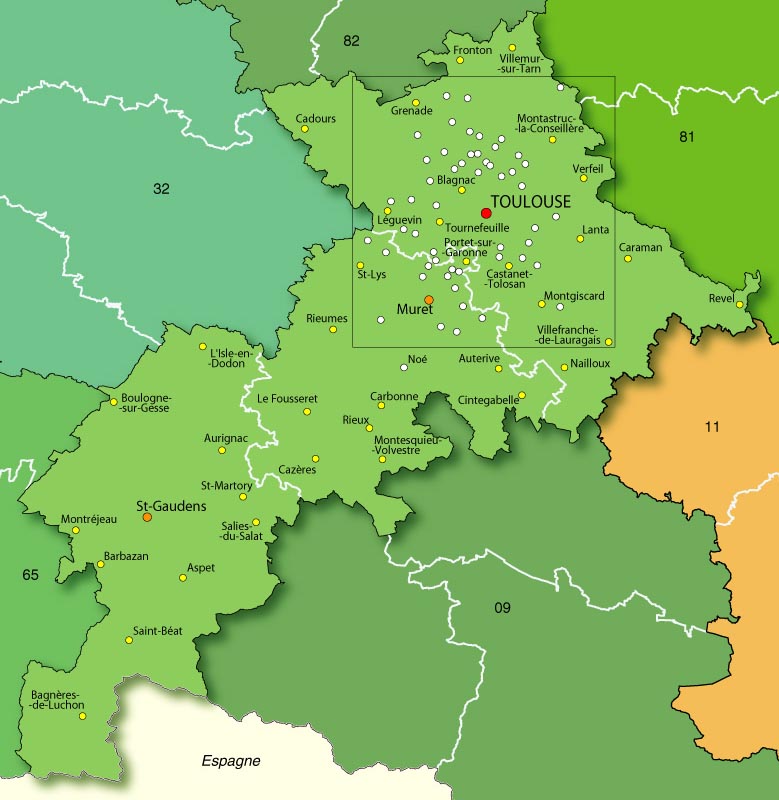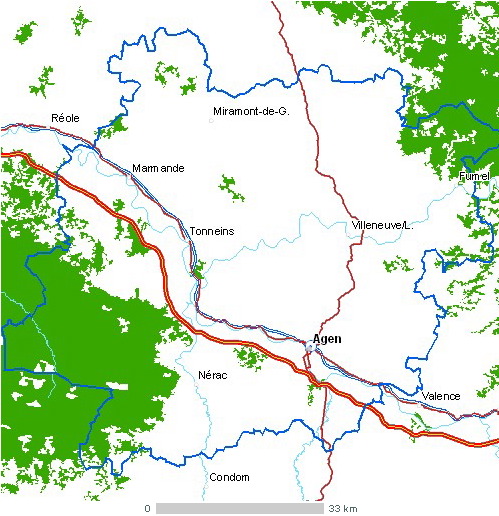|
Tarn-et-Garonne
Tarn-et-Garonne (; oc, Tarn e Garona ) is a department in the Occitania region in Southern France. It is traversed by the rivers Tarn and Garonne, from which it takes its name. The area was originally part of the former provinces of Quercy and Languedoc. The department was created in 1808 under Napoleon, with territory taken from the neighbouring Lot, Haute-Garonne, Lot-et-Garonne, Gers and Aveyron departments. The department is mostly rural with fertile agricultural land in the broad river valley, but there are hilly areas to the south, east and north. The departmental prefecture is Montauban; the sole subprefecture is Castelsarrasin. In 2019, it had a population of 260,669.Populations légales 2019: 82 Tarn-et-Garonne INSEE History History of the regi ...
|
Communes Of The Tarn-et-Garonne Department
The following is a list of the 195 communes of the Tarn-et-Garonne department of France. The communes cooperate in the following intercommunalities (as of 2020):BANATIC Périmètre des EPCI à fiscalité propre. Accessed 3 July 2020. * * Communauté de communes Coteaux et Plaines du Pays Lafrançaisain * [...More Info...] [...Related Items...] OR: [Wikipedia] [Google] [Baidu] |
Montauban
Montauban (, ; oc, Montalban ) is a commune in the Tarn-et-Garonne department, region of Occitania, Southern France. It is the capital of the department and lies north of Toulouse. Montauban is the most populated town in Tarn-et-Garonne, and the sixth most populated of Occitanie behind Toulouse, Montpellier, Nîmes, Perpignan and Béziers. In 2019, there were 61,372 inhabitants, called ''Montalbanais''. The town has been classified ''Ville d’art et d’histoire'' (City of art and history) since 2015. The town, built mainly of a reddish brick, stands on the right bank of the Tarn at its confluence with the Tescou. History Montauban is the second oldest (after Mont-de-Marsan) of the ''bastides'' of southern France. Its foundation dates from 1144 when Count Alphonse Jourdain of Toulouse, granted it a liberal charter. The inhabitants were drawn chiefly from Montauriol, a village which had grown up around the neighbouring monastery of St Théodard. In the 13th century ... [...More Info...] [...Related Items...] OR: [Wikipedia] [Google] [Baidu] |
Arrondissements Of The Tarn-et-Garonne Department
The 2 arrondissements of the Tarn-et-Garonne department of France are: # Arrondissement of Castelsarrasin, (subprefecture: Castelsarrasin) with 103 communes. The population of the arrondissement was 77,423 in 2016. # Arrondissement of Montauban, (prefecture of the Tarn-et-Garonne department: Montauban) with 92 communes. The population of the arrondissement was 179,474 in 2016. History In 1800, the arrondissement of Montauban was created as a part of the department Lot, and the arrondissement of Castelsarrasin as a part of the department Haute-Garonne. In 1808 the department of Tarn-et-Garonne was created, with the arrondissements of Montauban, Castelsarrasin and Moissac. The arrondissement of Moissac was deleted in 1926. References {{Arrondissements of France Tarn-et-Garonne Tarn-et-Garonne (; oc, Tarn e Garona ) is a department in the Occitania region in Southern France. It is traversed by the rivers Tarn and Garonne, from which it takes its name. The area was origina ... [...More Info...] [...Related Items...] OR: [Wikipedia] [Google] [Baidu] |
Castelsarrasin
Castelsarrasin (; oc, Los Sarrasins) is a commune in the Tarn-et-Garonne department in Occitanie region of France. The inhabitants are called ''Castelsarrasinois''. It is the second most populous commune in Tarn-et-Garonne after Montauban. It is served by Castelsarrasin station on the Bordeaux-Toulouse line. History The first certain evidence of the town dates from 961. The name, ''Castel Sarracenum'', would indicate that the castle was built in the Saracen era. The early history of the city is marked by wars; against the English until the end of the 12th century, then the Albigensian Crusade during the first part of the 13th century, and then the Shepherd's Crusade of 1320 that resulted in the deaths of many Jews in the city. The region was much affected by the Hundred Years' War, and again, during the wars of religion of the 16th century, the city's largely Catholic population was in frequent conflict with the generally Protestant surrounding region. The region is calm ... [...More Info...] [...Related Items...] OR: [Wikipedia] [Google] [Baidu] |
Languedoc
The Province of Languedoc (; , ; oc, Lengadòc ) is a former province of France. Most of its territory is now contained in the modern-day region of Occitanie in Southern France. Its capital city was Toulouse. It had an area of approximately 42,700 square kilometers (16,490 square miles). History The Roman province of Gallia Narbonensis fell to the Visigothic Kingdom from the 5th to the 8th centuries. Occupied briefly by the Emirate of Córdoba between 719 and 759, it was conquered and incorporated into the Kingdom of the Franks by Pippin the Short in 759 following the Siege of Narbonne. Under the Carolingians, the counts of Toulouse were appointed by the royal court. Later, this office became hereditary. Part of the territory where Occitan was spoken came to be called ''langue d'oc'', ''Lengadòc'' or Languedoc. In the 13th century, the spiritual beliefs of the area were challenged by the See of Rome and the region became attached to the Kingdom of France following the ... [...More Info...] [...Related Items...] OR: [Wikipedia] [Google] [Baidu] |
Cantons Of The Tarn-et-Garonne Department
The following is a list of the 15 cantons of the Tarn-et-Garonne department, in France, following the French canton reorganisation which came into effect in March 2015: * Aveyron-Lère * Beaumont-de-Lomagne * Castelsarrasin * Garonne-Lomagne-Brulhois * Moissac * Montauban-1 * Montauban-2 * Montauban-3 * Montech * Pays de Serres Sud-Quercy * Quercy-Aveyron * Quercy-Rouergue * Tarn-Tescou-Quercy vert * Valence * Verdun-sur-Garonne Verdun-sur-Garonne (, literally ''Verdun on Garonne''; oc, Verdun de Garona) is a commune in the Tarn-et-Garonne department in the Occitanie region in southern France. Monuments Verdun-sur-Garonne Hotel de Ville.jpg, Town Hall Église de l' ... References {{Cantons of France ... [...More Info...] [...Related Items...] OR: [Wikipedia] [Google] [Baidu] |
Quercy
Quercy (; oc, Carcin , locally ) is a former province of France located in the country's southwest, bounded on the north by Limousin, on the west by Périgord and Agenais, on the south by Gascony and Languedoc, and on the east by Rouergue and Auvergne. Description Quercy comprised the present-day department of Lot, the northern half of the department of Tarn-et-Garonne, and a few communities in the departments of Dordogne, Corrèze, and Aveyron. The traditional capital of Quercy is Cahors, now prefecture (capital) of Lot. The largest town of Quercy is Montauban, prefecture of Tarn-et-Garonne. However, Montauban lies at the traditional border between Quercy and Languedoc, in an area very different from the rest of Quercy, and it is closer historically and culturally to Toulouse and the rest of Languedoc, therefore it should be considered a special case, not totally part of Quercy. Also distinct from the rest of the region is the Quercy Blanc lying between Cahors and the southern ... [...More Info...] [...Related Items...] OR: [Wikipedia] [Google] [Baidu] |
Tarn (river)
The Tarn (; oc, Tarn, la, Tarnis, possibly meaning 'rapid' or 'walled in') is a long river in the administrative region of Occitania in southern France. It is a right tributary of the Garonne. The Tarn runs in a roughly westerly direction, from its source at an elevation of on Mont Lozère in the Cévennes mountains (part of the Massif Central), through the deep gorges and canyons of the Gorges du Tarn that cuts through the Causse du Larzac, to Moissac in Tarn-et-Garonne, where it joins the Garonne, downstream from the centre of town. Its basin covers approximately , and it has a mean flow of approximately . The Millau Viaduct spans the valley of the Tarn near Millau, and is now one of the area's most popular attractions. Main tributaries The tributaries of the Tarn include: * Agout (in Saint-Sulpice) * Alrance * Aveyron (near Montauban) * Cernon * Dourbie (in Millau) * Dourdou de Camarès * Jonte (in Le Rozier) * Lemboulas * Lumensonesque * Muze * Rance (near Tréb ... [...More Info...] [...Related Items...] OR: [Wikipedia] [Google] [Baidu] |
Occitania (administrative Region)
Occitania ( ; french: Occitanie ; oc, Occitània ; ca, Occitània ) is the southernmost administrative region of metropolitan France excluding Corsica, created on 1 January 2016 from the former regions of Languedoc-Roussillon and Midi-Pyrénées. The Council of State approved Occitania as the new name of the region on 28 September 2016, coming into effect on 30 September 2016. The modern administrative region is named after the larger cultural and historical region of Occitania, which corresponds with the southern third of France. The region of Occitania as it is today covers a territory similar to that ruled by the Counts of Toulouse in the 12th and 13th centuries. The banner of arms of the Counts of Toulouse, known colloquially as the Occitan cross, is used by the modern region and is also a popular cultural symbol. In 2015, Occitania had a population of 5,839,867. Toponymy Enacted in 2014, the territorial reform of French regions had been subject to debate for many years. ... [...More Info...] [...Related Items...] OR: [Wikipedia] [Google] [Baidu] |
List Of Presidents Of Departmental Councils (France)
In France, the President of the Departmental Council ( French: ''Président du Conseil départemental'') is the locally elected head of the departmental council, the assembly governing a department in France. The position is elected by the departmental councilors from among their number. If there is a tie, the senior councilor is elected. As per Articles L1111-1 to L7331-3 of the General code of local and regional authorities, the responsibilities of the President of the Departmental Council include: * Chairing the departmental authorities * Preparing and implementing the council's decisions * Collection of tax revenues * Representing the ''département'' in legal cases History In 1833, a law was enacted that gave each canton (subdivision of a department) representation of a councillor (''Conseiller général''). As a result of the decentralisation of government ( Deferre law), the election criteria were redefined in 1982 and the President of the Departmental Council took ov ... [...More Info...] [...Related Items...] OR: [Wikipedia] [Google] [Baidu] |
Haute-Garonne
Haute-Garonne (; oc, Nauta Garona, ; en, Upper Garonne) is a department in the Occitanie region of Southwestern France. Named after the river Garonne, which flows through the department. Its prefecture and main city is Toulouse, the country's fourth-largest. In 2019, it had a population of 1,400,039.Populations légales 2019: 31 Haute-Garonne INSEE History Haute-Garonne is one of the original 83 departments created during the on 4 March 1790. It was created from part of the former provinces of an ...[...More Info...] [...Related Items...] OR: [Wikipedia] [Google] [Baidu] |
Lot-et-Garonne
Lot-et-Garonne (, oc, Òlt e Garona) is a department in the Nouvelle-Aquitaine region of Southwestern France. Named after the rivers Lot and Garonne, it had a population of 331,271 in 2019.Populations légales 2019: 47 Lot-et-Garonne INSEE Its and largest city is . History Lot-et-Garonne is one of the original 83 departments created on 4 March 1790, as a result of the ...[...More Info...] [...Related Items...] OR: [Wikipedia] [Google] [Baidu] |




